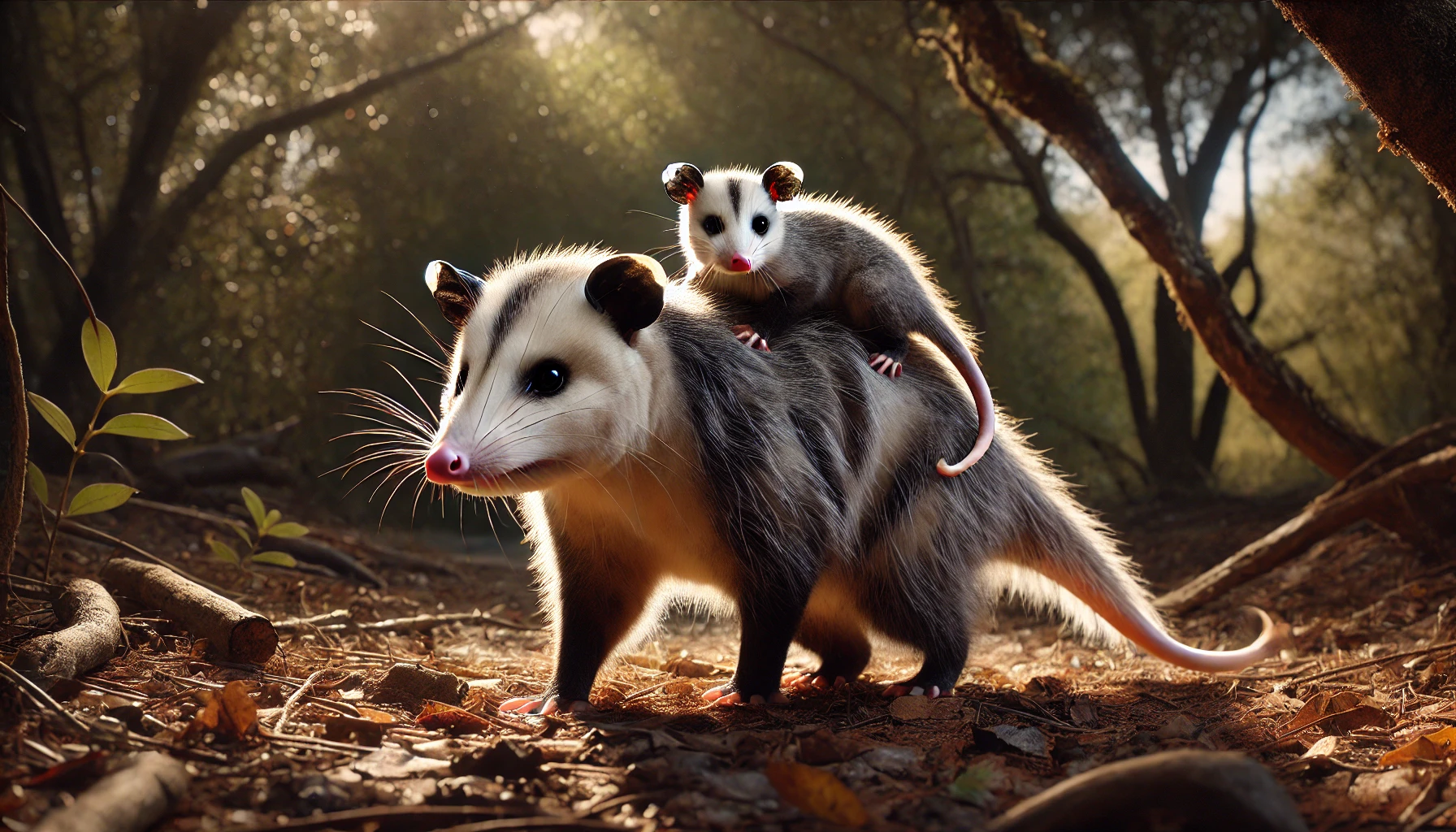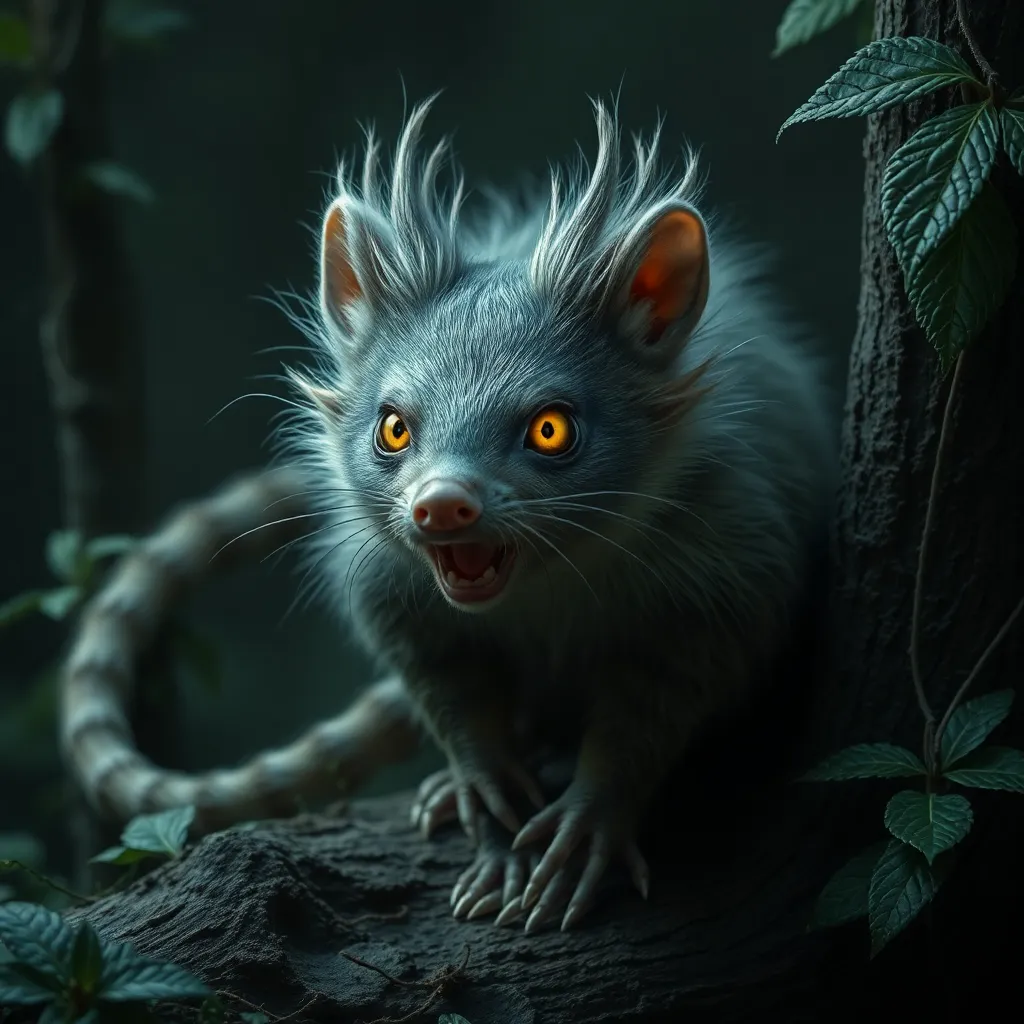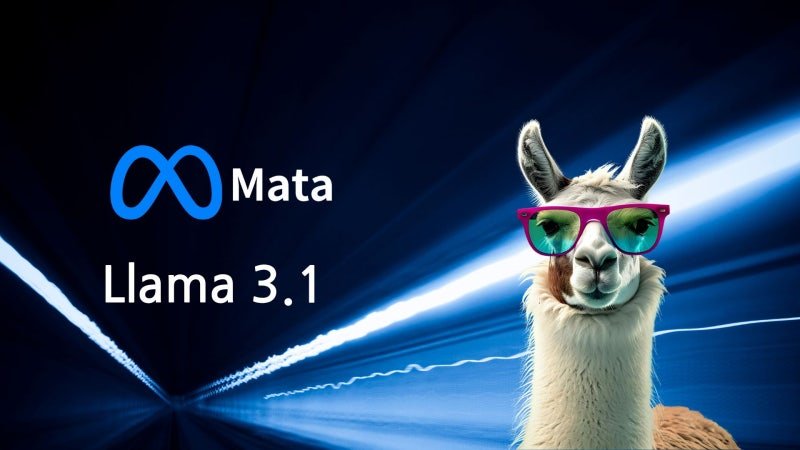BLOG
The Fascinating World of Tlacuaches: Nature’s Little Helpers

Introduction
Often misunderstood and sometimes feared, tlacuaches (opossums) are incredible creatures with a significant role in our ecosystems. Known for their unusual appearance and behavior, these marsupials are native to the Americas and have adapted to live in a wide variety of habitats. Despite the myths surrounding them, tlacuaches are beneficial animals, contributing to pest control and maintaining ecological balance. In this post, we will explore everything you need to know about tlacuaches, from their unique biology to their cultural significance and their role in nature.
What Is a Tlacuache?
The word tlacuache comes from the Nahuatl word tlacuatzin, which means “small one who eats.” Tlacuache are commonly known in English as opossums, specifically the Virginia opossum (Didelphis virginiana). They are the only marsupials found in North America, with relatives throughout Central and South America.
These creatures are often recognized by their grayish fur, hairless tails, and pointed snouts. They are nocturnal and mostly solitary, known for their ability to adapt to urban environments as well as natural habitats like forests, grasslands, and wetlands.
Unique Biology of Tlacuaches
One of the most distinctive features of the tlacuache is that it is a marsupial, meaning females carry and nurse their young in a pouch. This sets them apart from other mammals in North America. Similar to kangaroos and koalas, a mother opossum gives birth to tiny, underdeveloped babies (called joeys), which crawl into her pouch to continue their development for several weeks.
Anatomy and Survival Skills
1. Prehensile Tails: Tlacuaches have long, hairless, and prehensile tails that they use to grip branches and carry small objects. Contrary to popular belief, adult opossums do not hang from trees by their tails, but their tails do provide extra balance and mobility when climbing.
2. Immunity to Snake Venom: One of the most remarkable traits of tlacuaches is their partial immunity to the venom of pit vipers, including rattlesnakes. This makes them valuable in controlling snake populations in their habitats.
3. Playing Dead: When faced with danger, tlacuaches are famous for “playing dead,” a phenomenon known as thanatosis. During this state, they involuntarily collapse and mimic the appearance and smell of a dead animal, fooling predators who prefer live prey. This can last from several minutes to hours, depending on the threat.
4. Omnivorous Diet: Tlacuaches are opportunistic omnivores, meaning they eat a wide range of foods, including fruits, insects, small animals, and even carrion. Their diet is one of the reasons they are considered beneficial for pest control, as they consume ticks, rodents, and insects.
The Ecological Role of Tlacuaches
Despite their often negative portrayal, tlacuaches play an essential role in maintaining healthy ecosystems. Here are some key ways they contribute:
1. Natural Pest Control
One of the most important contributions of tlacuaches is their role in controlling pest populations. They eat a variety of insects, including beetles, crickets, and cockroaches, as well as small rodents like mice and rats. This natural pest control helps reduce the spread of diseases and the damage caused by pests in both urban and rural areas.
2. Tick Reduction
Tlacuaches are known to consume large quantities of ticks. Studies have shown that a single opossum can eat thousands of ticks in a single season, significantly reducing the spread of tick-borne illnesses such as Lyme disease. This makes them important allies in preventing the proliferation of ticks, especially in areas with high populations of deer, which are primary hosts for ticks.
3. Seed Dispersal
As omnivores, tlacuaches often consume fruits, and in doing so, they help with seed dispersal. By spreading seeds through their feces, they contribute to the growth of new plants and the regeneration of forests. This helps maintain biodiversity and promotes healthy ecosystems.
Tlacuaches in Culture and Mythology

Tlacuaches have a long history in the folklore and mythology of indigenous cultures in the Americas. In ancient Mesoamerican mythology, the tlacuache was considered a trickster figure, often depicted as cunning and resourceful.
Tlacuache as the Fire-Bringer
One of the most famous myths involving the tlacuache comes from Mexican folklore. According to legend, the tlacuache was responsible for bringing fire to humans. The story goes that in ancient times, humans did not have fire, and the gods kept it to themselves. The clever tlacuache decided to steal fire from the gods by hiding a burning ember in its tail. Though the ember burned off the hair on the tlacuache’s tail, it successfully brought fire to humans, and to this day, opossums have hairless tails as a reminder of this brave act.
Symbolism in Modern Culture
In modern times, tlacuaches are often seen as symbols of survival and adaptability. Their ability to thrive in a variety of environments, including urban settings, reflects their resilience. Though they are sometimes viewed as pests, their ecological benefits and unique characteristics have led to a growing appreciation for these creatures.
Misconceptions and Myths about Tlacuaches
Like many misunderstood animals, tlacuaches have been the subject of numerous myths and misconceptions. Some of these have led to fear or hostility towards these creatures. Let’s clear up some of the most common misconceptions:
1. Tlacuaches Are Aggressive
Many people believe that tlacuaches are aggressive and prone to attacking humans. In reality, tlacuaches are shy and non-confrontational animals. When threatened, they are far more likely to run away or play dead than to fight. While they may hiss or bare their teeth when cornered, they rarely pose a threat to humans or pets.
2. They Carry Rabies
Another common misconception is that tlacuaches frequently carry rabies. In fact, opossums have a lower body temperature than most mammals, which makes it difficult for the rabies virus to survive in their bodies. While any wild animal can potentially carry diseases, tlacuaches are less likely to transmit rabies than other mammals like raccoons or bats.
3. They Are Dirty and Spread Disease
Because tlacuaches are scavengers and often seen rummaging through trash, some people assume they are dirty and spread diseases. However, tlacuaches are actually fastidious groomers, similar to cats. They are known to clean themselves regularly and are no more likely to spread disease than any other wild animal. In fact, their presence can help reduce the number of disease-carrying pests like ticks and rats.
The Importance of Coexisting with Tlacuaches
As urban areas expand, encounters between humans and wildlife, including tlacuaches, are becoming more frequent. Rather than viewing tlacuaches as nuisances, it’s important to recognize their valuable contributions to the environment and learn to coexist with them.
How to Live Harmoniously with Tlacuaches
If you live in an area where tlacuaches are common, there are simple steps you can take to minimize conflicts:
Secure Your Garbage: Tlacuaches are attracted to easily accessible food sources like trash cans. Using animal-proof bins can help keep them away from your home.
Close Off Entry Points: Make sure there are no open spaces where tlacuaches can enter your attic, basement, or crawl spaces. Sealing up these areas will prevent them from nesting in or around your home.
Use Humane Deterrents: If you don’t want tlacuaches in your yard, consider using humane deterrents such as motion-activated lights or sprinklers to discourage them from coming too close.
Conclusion
Tlacuaches are remarkable creatures that play an essential role in maintaining ecological balance. Despite the myths and misconceptions surrounding them, they are gentle, beneficial animals that deserve our respect and protection. From controlling pests and reducing ticks to dispersing seeds and even featuring in ancient mythology, tlacuaches have made their mark on both nature and culture. As we continue to share our spaces with wildlife, it’s important to appreciate the role these fascinating marsupials play in keeping our ecosystems healthy.
FAQs
Q: Do tlacuaches make good pets?
A: Tlacuaches are wild animals and are not suited for domestication. In most places, it is illegal to keep them as pets.
Q: How long do tlacuaches live?
A: In the wild, tlacuaches have a relatively short lifespan of about 2 to 4 years, but they can live longer in captivity.
Q: What should I do if I find a tlacuache in my yard?
A: If the tlacuache is not causing harm, it’s best to leave it alone. If it appears injured or in danger, contact a local wildlife rehabilitator for advice.
Q: Are tlacuaches dangerous to pets?
A: Tlacuaches are generally non-aggressive and prefer to avoid confrontations. They are not a threat to most pets unless cornered, in which case they might defend themselves by hissing or playing dead.
Share this content:
BLOG
Your Topics | Multiple Stories to Educate and Inspire

In today’s fast-paced world, stories are a powerful medium to entertain, educate, and inspire. Whether you’re looking for motivational tales, fictional escapes, or informative narratives, exploring your topics | multiple stories can open up a world of knowledge and creativity. This blog will dive into various types of stories that captivate readers and leave lasting impressions.
Why Stories Are Important
Stories have always been a fundamental way of sharing experiences, knowledge, and culture. They allow us to connect with others, understand different perspectives, and explore emotions. With your topics | multiple stories, you can find narratives that resonate with your interests, making every read both enjoyable and meaningful.
Inspiring Real-Life Stories
1. Overcoming Adversity
One of the most compelling categories within your topics | multiple stories is about individuals overcoming challenges. From people battling life-threatening illnesses to entrepreneurs building businesses from scratch, these stories remind us of the power of resilience and determination.
Take, for example, a tale of a small-town athlete who faced financial struggles but went on to win international medals. Such stories inspire and motivate others to chase their dreams, no matter the obstacles.
2. Acts of Kindness
Stories of kindness and generosity can warm your heart and restore your faith in humanity. Whether it’s about strangers helping each other in emergencies or communities coming together to aid those in need, these stories are a valuable part of your topics | multiple stories.
Fictional Tales That Spark Creativity

If you’re someone who loves to escape reality for a while, fictional stories are your gateway to a world of imagination.
1. Adventures in Fantasy Worlds
Fantasy stories transport readers to magical lands filled with heroes, villains, and mythical creatures. They provide an escape from the mundane and encourage us to dream big. In your topics | multiple stories, fantasy adventures often feature narratives of bravery, friendship, and hope that resonate with readers.
2. Gripping Mysteries
Mystery stories keep readers on the edge of their seats. A well-crafted mystery engages the mind, prompting readers to solve puzzles and uncover secrets. These stories are an exciting addition to any collection of your topics | multiple stories, appealing to both casual and avid readers.
Educational Narratives for Growth
Not all stories are meant for entertainment—many are designed to educate and inform.
1. Historical Accounts
History comes alive through stories. By exploring the lives of historical figures or pivotal events, readers can better understand the world and its complexities. Historical narratives are a significant part of your topics | multiple stories, helping us learn from the past.
2. Science and Innovation
Stories about groundbreaking scientific discoveries or technological advancements are fascinating and inspiring. They showcase human ingenuity and highlight the importance of curiosity and perseverance.
The Impact of Sharing Your Own Stories
Have you ever thought about sharing your story? Every individual has a unique journey worth telling. Contributing to your topics | multiple stories allows you to connect with others who may relate to your experiences.
For instance:
- Did you overcome a personal challenge?
- Have you embarked on a life-changing adventure?
- Do you have a lesson that could benefit others?
Your story might inspire someone to take the first step toward their own dreams.
How to Find and Share Stories
The internet offers a wealth of platforms to discover and share stories. From personal blogs to social media and online forums, the opportunities are endless. If you’re looking for high-quality narratives, explore curated collections or websites dedicated to your topics | multiple stories.
When sharing your story, consider these tips:
- Keep it Authentic: Share your genuine experiences and emotions.
- Engage Your Audience: Use a relatable tone and clear language.
- Optimize for SEO: If you’re publishing online, ensure your content is optimized to reach a broader audience.
Conclusion
Stories are a universal language that inform, entertain, and inspire. By diving into your topics | multiple stories, you can discover a wide range of narratives that align with your interests and goals. Whether it’s a tale of personal triumph, a fictional adventure, or an educational insight, stories enrich our lives in countless ways.
Take a moment today to explore new stories or share your own. You never know how a single narrative could impact someone’s life or provide them with the inspiration they need.
Share this content:
BLOG
The Ultimate Guide to Torrent Sites in 2024: Everything

Torrent sites are a popular way for millions of people worldwide to share and download files. From movies and TV shows to software, music, and eBooks, torrents have revolutionized how digital content is distributed. But not all torrent sites are created equal, and using them responsibly requires understanding the risks and benefits. In this blog, we’ll dive into everything you need to know about torrent sites in 2024.
What Are Torrent Sites?
Torrent sites are online platforms that host torrent files and magnet links, allowing users to download and share content using peer-to-peer (P2P) file-sharing technology. Instead of downloading files from a single server, torrents divide the content into smaller parts shared among multiple users (peers). This decentralized approach increases download speeds and reduces server costs.
Popular torrent clients like uTorrent, BitTorrent, and qBittorrent enable users to access and manage torrent files easily.
Top Torrent Sites in 2024
1. The Pirate Bay
Overview: Often called the “king of torrents,” The Pirate Bay has been a favorite for years. It hosts a vast library of torrents, including movies, games, music, and software.
Pros: High availability, user-friendly interface, and a strong community for verifying files.
Cons: Frequent domain changes and legal scrutiny in several countries.
2. RARBG
Overview: Known for its high-quality content, especially in movies and TV shows, RARBG stands out for providing detailed descriptions and screenshots.
Pros: Quality assurance and excellent seeder-to-leecher ratios.
Cons: Restricted access in several countries.
3. 1337x
Overview: This user-friendly site is perfect for beginners. It offers a broad range of content, including trending TV shows, games, and software.
Pros: Modern design and active user reviews for safe downloads.
Cons: Some torrents may have fewer seeders.
4. YTS
Overview: Focused on high-quality movie torrents, YTS is ideal for those who want smaller file sizes without compromising quality.
Pros: Compact file sizes and excellent video quality.
Cons: Limited to movies; no software or games.
5. EZTV
Overview: A go-to torrent site for TV show enthusiasts. It offers a wide selection of episodes from classic and current series.
Pros: Consistent updates and easy navigation.
Cons: Ads can be intrusive.
Is Downloading from Torrent Sites Legal?
This question doesn’t have a one-size-fits-all answer. Torrenting itself is not illegal—it’s a technology. However, the legality of downloading or sharing files depends on the content. For example:
Legal Torrents: Open-source software, public domain content, and files with explicit permission for sharing.
Illegal Torrents: Copyrighted movies, music, or software shared without authorization.
Downloading illegal content can result in fines, lawsuits, or even jail time, depending on local laws. Always verify the legality of the files before downloading.
Risks of Using Torrent Sites
While torrenting offers convenience, it comes with several risks:
1. Malware and Viruses
Torrent files can sometimes include malicious software. Downloading from unverified sources may infect your device with malware or ransomware.
2. Privacy Concerns
Since torrenting relies on P2P sharing, your IP address is visible to other users in the network. Hackers or even government agencies can track your activity.
3. Legal Issues
Using torrent sites to download copyrighted content may lead to penalties or legal action.
4. Fake Torrents
Some torrents are misleading and may contain harmful or irrelevant content.
How to Torrent Safely

To reduce risks while using torrent sites, follow these best practices:
1. Use a VPN
A Virtual Private Network (VPN) hides your IP address, encrypts your connection, and ensures privacy while torrenting. Top VPNs for torrenting include NordVPN, ExpressVPN, and CyberGhost.
2. Choose Trusted Sites
Stick to reputable torrent sites like The Pirate Bay, 1337x, or RARBG. Avoid unknown platforms with limited user reviews.
3. Check Seeder-to-Leecher Ratio
Files with a high number of seeders download faster and are usually more reliable.
4. Install Antivirus Software
A robust antivirus program protects your device from malware embedded in torrent files.
5. Read Reviews
Check user comments and ratings on torrent files before downloading. Verified torrents are less likely to have harmful content.
Legal Alternatives to Torrenting
For those seeking a safer and legal way to access content, consider the following alternatives:
1. Streaming Services: Platforms like Netflix, Amazon Prime, Hulu, and Disney+ offer extensive libraries of movies and shows.
2. Free Content Platforms: Websites like YouTube and Vimeo provide legal access to free videos and music.
3. Open-Source Resources: Websites like Project Gutenberg and Free Music Archive offer public domain books and music.
The Future of Torrent Sites
As governments worldwide crack down on illegal torrenting, the landscape of torrent sites continues to evolve. New sites emerge, while established ones adapt to avoid legal consequences. In 2024, using torrent sites responsibly and securely is more important than ever.
Conclusion
Torrent sites remain a valuable resource for sharing and downloading files, but they come with responsibilities and risks. Always prioritize safety by using trusted sites, enabling VPNs, and avoiding illegal content. By doing so, you can enjoy the benefits of torrenting without compromising your security or facing legal troubles.
FAQs
1. Are torrent sites free to use?
Yes, most torrent sites are free, but some may include premium options or donations.
2. Can torrenting harm my computer?
Downloading files from untrusted sources can expose your device to malware or viruses. Use antivirus software to stay protected.
3. Is a VPN necessary for torrenting?
Yes, a VPN ensures privacy and security by hiding your IP address and encrypting your connection.
4. What are the best alternatives to torrenting?
Streaming services like Netflix or legal open-source platforms like Project Gutenberg offer safe alternatives.
By staying informed and cautious, you can navigate the torrenting world effectively in 2024.
Share this content:
BLOG
Kennedy Funding Lawsuit: An Overview

Kennedy Funding Lawsuit: An Overview
Kennedy Funding, a well-known name in the commercial real estate financing sector, has faced its share of challenges over the years. Among these are legal battles that have garnered attention, particularly lawsuits involving allegations of misconduct, disputes over funding agreements, or other issues. This blog provides an in-depth look at the Kennedy Funding lawsuit, exploring its background, potential implications, and what it signifies for borrowers, lenders, and the real estate financing industry.
What is Kennedy Funding?
Kennedy Funding is a global direct private lender specializing in bridge loans for real estate transactions. The firm is renowned for its ability to provide funding quickly, often for high-risk or unconventional projects that traditional banks might avoid. These include:
Commercial real estate loans
Land acquisition financing
Construction loans
Restructuring debt
While Kennedy Funding has helped many clients secure financing for critical projects, its unconventional lending approach has occasionally led to legal disputes.
Background of the Kennedy Funding Lawsuit

The lawsuits involving Kennedy Funding typically stem from disagreements over loan terms, allegations of breach of contract, or accusations of misleading practices. Borrowers or business partners may file claims if they feel misrepresented or believe the lender has failed to honor its commitments.
Some common issues that have been highlighted in lawsuits include:
1. Loan Disputes
Borrowers may claim that loan terms were not adequately disclosed or that Kennedy Funding failed to deliver promised financing within agreed timelines. These disputes often arise in high-stakes real estate projects where delays can have significant financial repercussions.
2. Breach of Contract
Accusations of breaching loan agreements are another common theme in lawsuits. Borrowers or partners may allege that Kennedy Funding failed to adhere to agreed-upon terms, leading to project delays or financial losses.
3. Predatory Lending Accusation
Some lawsuits have accused Kennedy Funding of engaging in predatory lending practices, such as imposing high-interest rates or hidden fees that borrowers claim were not transparent at the outset.
4. Misrepresentation
Borrowers might argue that they were misled about the nature or terms of their loans, leading to financial strain or an inability to complete projects as planned.
Key Takeaways from Kennedy Funding Lawsuits
The lawsuits surrounding Kennedy Funding highlight critical lessons for borrowers and lenders alike. Here are some key takeaways:
1. Transparency is Crucial
Both borrowers and lenders must prioritize transparency in all financial dealings. Clear communication about loan terms, interest rates, fees, and timelines can prevent misunderstandings and disputes.
2. Thorough Documentation
Legal disputes often hinge on documentation. Borrowers should ensure that all agreements are in writing and reviewed by legal counsel before signing. Similarly, lenders like Kennedy Funding must maintain detailed records of all transactions and agreements.
3. Due Diligence is Key
Borrowers must conduct due diligence on lenders, especially when working with non-traditional financing sources. Understanding a lender’s reputation, past lawsuits, and track record can help avoid potential pitfalls.
4. Legal Recourse is an Option
In cases where disputes cannot be resolved amicably, legal recourse may be necessary. Borrowers and lenders alike should be prepared for the financial and reputational costs of lawsuits.
Implications for Borrowers
Borrowers considering working with Kennedy Funding or similar private lenders should take note of the potential risks highlighted by these lawsuits. Here are some steps to mitigate risks:
Understand the Terms: Ensure you fully understand loan terms, including interest rates, repayment schedules, and any penalties for non-compliance.
Seek Legal Advice: Before signing any agreements, consult with legal and financial advisors to ensure the terms are fair and enforceable.
Plan for Contingencies: High-risk projects often face unforeseen challenges. Borrowers should have contingency plans in place to address delays or funding issues.
Implications for Kennedy Funding
For Kennedy Funding, lawsuits can impact its reputation and client trust. To maintain credibility and continue operating successfully, the company should:
Enhance Transparency: Providing clear, comprehensive documentation and addressing borrower concerns proactively can help rebuild trust.
Strengthen Compliance: Ensuring compliance with all regulatory requirements and industry best practices is essential for avoiding future disputes.
Focus on Customer Relations: Building strong relationships with clients and addressing complaints swiftly can mitigate the risk of lawsuits.
Broader Impact on the Real Estate Financing Industry
The Kennedy Funding lawsuit is not an isolated event; it reflects broader challenges in the real estate financing sector, particularly in the realm of private lending. Key takeaways for the industry include:
Regulatory Oversight: Increased scrutiny from regulators could help ensure fair lending practices and protect borrowers from potential misconduct.
Evolving Business Models: Lenders may need to adapt their business models to align with borrower expectations and legal standards.
Education for Borrowers: Borrowers must be educated about their rights and responsibilities when securing financing, particularly from non-traditional lenders.
Conclusion
The Kennedy Funding lawsuit serves as a cautionary tale for both borrowers and lenders in the real estate financing space. While Kennedy Funding has built a reputation as a fast and flexible lender, legal disputes underscore the importance of transparency, thorough documentation, and due diligence.
For borrowers, understanding the terms of any loan agreement and seeking professional advice can prevent costly mistakes. For lenders, maintaining ethical practices and addressing client concerns proactively is critical for long-term success.
As the real estate financing industry evolves, cases like the Kennedy Funding lawsuit remind us that trust, transparency, and accountability are essential for navigating high-stakes transactions. Whether you’re a borrower or lender, these lessons are invaluable for achieving success while minimizing risks.
Share this content:
-

 App6 months ago
App6 months agoExperience Unlimited Entertainment with Castle APK for Android
-

 Health6 months ago
Health6 months agoВетеринарная клиника VetCityPets: Забота о вашем питомце на высшем уровне
-

 AI8 months ago
AI8 months agoUnderstanding 라마 3.1: Features, Benefits, and Applications
-

 Business8 months ago
Business8 months agoSnow Day Calculator: How to Predict School Closures
-

 Business7 months ago
Business7 months agoLand Rover Defender vs. Toyota Land Cruiser: Battle of the Luxury Off-Roaders
-

 Ronaldo8 months ago
Ronaldo8 months agoRonald Acuña Jr.: The Rise of a Baseball Superstar
-

 BLOG8 months ago
BLOG8 months agoThe Ultimate Guide to Becoming a Car Guru: Tips for Car Enthusiasts and Buyers
-

 Travel6 months ago
Travel6 months agoExplore Mega-Personal.net Travel Archives: Your Gateway

Pingback: Tiny Rhea: My Own Personal Freak – A Journey of Embracing Uniqueness - ronaldo.com.in